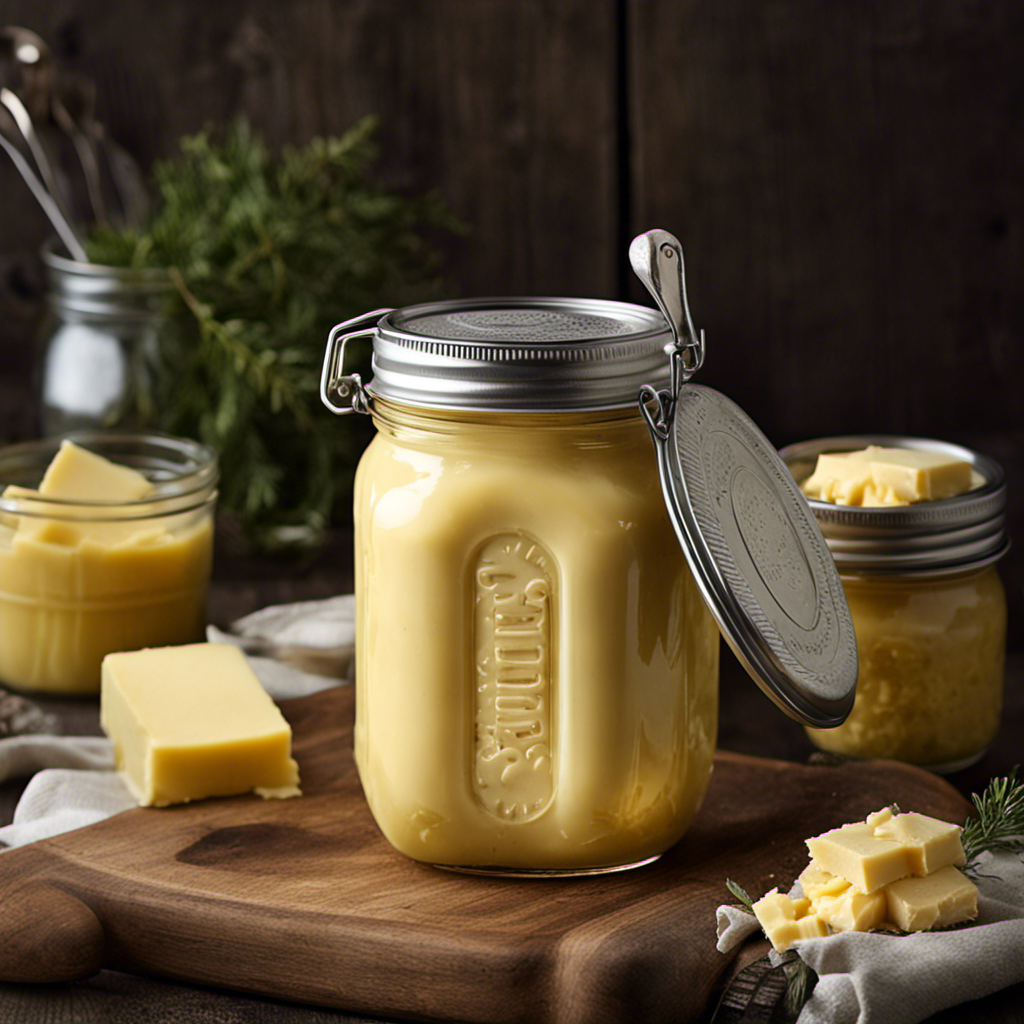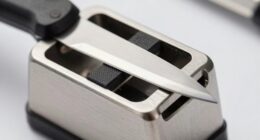I have to admit, incorporating butter into recipes is a skill. It is the key to achieving that ideal texture in your baked treats.
In this article, I will guide you through the tools needed, different methods, and tips for mastering this technique. Together, we will unravel the purpose behind cutting in butter and learn how to avoid common mistakes.
Get ready to elevate your baking game as we delve into the precise world of cutting in butter.
Key Takeaways
- Tools needed for cutting in butter include a pastry blender or two knives.
- Cold butter is beneficial for creating flaky layers and a tender texture.
- Achieving the perfect crumb involves using a pastry cutter for control and precision.
- Pay attention to specific instructions for different recipes and consider alternative ingredients for dietary restrictions.
Tools Needed for Cutting in Butter
To cut in butter, you’ll need a pastry blender or two knives. These tools are essential for achieving the desired texture in your baked goods.
A pastry blender consists of several curved metal blades that are attached to a handle. It allows you to easily break down the butter into small pieces, which helps create a flaky and tender texture.
Alternatively, you can use two knives to cut the butter into the dry ingredients. Hold one knife in each hand and cut the butter by crossing the knives in a scissor-like motion. This method requires a bit more effort and precision, but it can yield excellent results.
Now that we have discussed the best tools for cutting in butter, let’s explore the different methods for achieving this technique.
Different Methods for Cutting in Butter
When it comes to cutting in butter, there are two main methods to consider: using a fork or a pastry cutter.
Using a fork involves repeatedly pressing the tines into the butter to break it up into smaller pieces, while a pastry cutter is a specialized tool that cuts the butter into the flour using multiple blades.
The choice between these methods depends on personal preference and the desired outcome of the final product.
Additionally, the temperature of the butter also plays a crucial role in the cutting-in process, with some recipes calling for cold butter and others for room temperature butter.
Understanding the impact of temperature on the final result is essential for achieving the desired texture and consistency in baked goods.
Fork or Pastry Cutter
Use a pastry cutter or fork to easily cut in the butter for a flaky texture in your pastry dough.
When it comes to cutting in butter, there are two main methods: using a pastry cutter or using a fork.
The pastry cutter is a tool specifically designed for this purpose. It consists of several stainless steel blades attached to a handle. By pressing the blades into the butter and repeatedly cutting through it, you can achieve a uniform distribution throughout the dough.
On the other hand, using a fork is an alternative method. Simply hold the fork in one hand and use a stabbing motion to break up the butter into smaller pieces. This method requires a bit more effort and precision, but it can still yield satisfactory results.
Ultimately, the choice between a pastry cutter and a fork depends on personal preference and the desired outcome.
Cold or Room Temperature?
The choice between cold or room temperature butter greatly impacts the texture of your pastry dough.
When it comes to incorporating butter into your dough, using cold butter has its benefits. Cold butter contains more water, which helps create steam during baking, resulting in flaky layers. The cold butter also stays solid for longer, which helps create a tender and crumbly texture in your pastries.
When using cold butter, it is essential to cut it into small pieces and incorporate it quickly into the dough to prevent it from melting. This will ensure that the butter remains in solid form, allowing for the formation of those desired flaky layers.
Tips for Achieving the Perfect Crumb With Butter Cutting
When it comes to achieving the perfect crumb in baked goods, the choice between using a blade or a pastry cutter can make all the difference. Personally, I prefer using a pastry cutter as it allows for more control and precision when cutting in the butter.
Additionally, it is crucial to work with cold butter as it helps create those desirable pockets of fat that lead to a tender and flaky texture.
Lastly, over-mixing the dough can be detrimental to achieving the perfect crumb, as it can result in a tough and dense final product.
Blade Vs. Pastry Cutter
To achieve the desired texture, it’s best to use a pastry cutter instead of a blade when cutting in butter. The efficiency comparison between the two tools is significant. Here’s why:
-
Blade:
-
Can be difficult to control, resulting in uneven butter distribution.
-
Requires more effort and time to achieve the desired consistency.
-
Can easily overwork the dough, leading to a tough end product.
-
Pastry Cutter:
-
Designed specifically for cutting in butter, ensuring even distribution.
-
Provides a quicker and more efficient process.
-
Allows for precise control, preventing overworking of the dough.
Cold Butter Is Essential
Using cold butter is crucial for achieving the desired texture when cutting in butter. The temperature of the butter plays a significant role in the success of this process. When the butter is cold, it remains solid, allowing it to be easily incorporated into the dry ingredients without melting too quickly.
To cut in cold butter effectively, there are various tools and techniques to consider. Pastry cutters and knives with a sharp blade are commonly used for this purpose. The pastry cutter helps to break the butter into small, pea-sized pieces, while a sharp knife can be used to create a crumbly texture.
It is important to avoid over-mixing the butter, as this can lead to a loss of texture and result in a dense, tough end product.
Transitioning to the next section, over-mixing ruins texture and should be avoided.
Over-Mixing Ruins Texture
Make sure not to over-mix the ingredients, as this can ruin the texture of your final product. Over-mixing occurs when the ingredients are mixed for too long, causing them to become overworked and resulting in a dense or tough texture.
To avoid this, it is important to use the right tools and adjust your cutting techniques. Here are some tips to achieve the perfect crumb:
-
Use a pastry cutter or two knives to cut the butter into the dry ingredients. This helps to distribute the butter evenly and create pockets of air for a light and flaky texture.
-
Be gentle and use a light touch when cutting in the butter. Avoid pressing too hard, as this can lead to over-mixing.
-
Adjust the cutting technique based on the recipe. For recipes that call for a crumbly texture, cut the butter into smaller pieces. For recipes that require a more tender texture, leave larger chunks of butter.
Understanding the purpose of cutting in butter is crucial for achieving the desired texture in your baked goods.
Understanding the Purpose of Cutting in Butter
Understanding the purpose of cutting in butter is essential for achieving a flaky and tender pastry crust.
When it comes to cutting in butter, there are a few tools that can make the process easier. One commonly used tool is a pastry cutter, which is a handheld tool with curved blades that cut through the butter, incorporating it into the dry ingredients.
Another tool that can be used is a food processor, which quickly cuts the butter into small pieces.
The importance of butter cutting in baking is that it creates pockets of fat in the dough. As the pastry bakes, the fat melts, creating steam and causing the layers of dough to separate, resulting in a light and flaky texture. Understanding this purpose will help bakers achieve the desired texture in their pastries.
Now, let’s explore some common mistakes to avoid when cutting in butter.
Common Mistakes to Avoid When Cutting in Butter
To achieve a flaky and tender pastry crust, it’s important to avoid rushing the process of cutting in butter. This step is crucial in creating the desired texture and ensuring even distribution of fat throughout the dough.
When cutting in butter, there are some common mistakes that can lead to less than perfect results. Here are a few troubleshooting tips to help you achieve the best outcome:
-
Tools for cutting butter:
-
Pastry blender: This handheld tool is designed specifically for cutting butter into flour. It has multiple curved blades that make the process easier and more efficient.
-
Two knives: If you don’t have a pastry blender, you can use two knives in a scissor-like motion to cut the butter into small pieces.
-
Troubleshooting common issues in cutting in butter:
-
Butter melting too quickly: Make sure your butter is cold and firm before starting. Chill it in the refrigerator for at least 30 minutes.
-
Uneven distribution: Cut the butter into small, pea-sized pieces and distribute them evenly throughout the flour. Avoid overmixing, as it can result in a tough crust.
How to Determine the Consistency of Butter for Cutting in
When determining the consistency of butter for cutting in, it’s important to feel the texture with your fingers. This step is crucial in achieving a perfect crumb in your baked goods.
To begin, take the butter out of the refrigerator and let it soften slightly at room temperature. You want the butter to be cool to the touch but pliable.
Gently press your fingers into the butter and observe its resistance. If the butter feels too soft and your fingers sink in easily, it is too warm. On the other hand, if the butter feels hard and doesn’t give much when pressed, it is too cold.
The ideal consistency is when the butter yields slightly to gentle pressure, leaving an indentation without being too soft. This allows for proper incorporation into the dry ingredients, resulting in a tender and flaky crumb.
Adjusting Cutting Techniques for Different Recipes
For adjusting cutting techniques in different recipes, it’s important to pay attention to the specific instructions provided.
When it comes to vegan recipes, you may need to adjust your cutting techniques to accommodate the absence of animal-based ingredients. One way to do this is by using plant-based margarine or coconut oil as a substitute for butter. These options have similar consistencies to butter and can be cut into dry ingredients using the same method.
On the other hand, if you are working with gluten-free recipes, you may need to consider the different texture and density of gluten-free flours. It’s important to adjust your cutting technique accordingly to ensure proper incorporation of the fat.
By adapting your cutting techniques for vegan and gluten-free recipes, you can achieve the desired results while accommodating dietary restrictions and preferences.
Now let’s explore alternative ingredients for cutting in butter.
Alternative Ingredients for Cutting in Butter
Using plant-based margarine or coconut oil as a substitute can achieve a similar consistency to butter when cutting ingredients.
When it comes to alternative methods for cutting in butter, vegan substitutes like plant-based margarine or coconut oil can be excellent options. These alternatives provide a similar texture and consistency to butter, allowing for a seamless incorporation into recipes.
Plant-based margarine, made from vegetable oils, has a creamy, spreadable texture that blends well with dry ingredients. Coconut oil, on the other hand, is solid at room temperature and offers a rich, buttery flavor.
To use these substitutes, simply replace an equal amount of butter with either plant-based margarine or coconut oil and proceed with the cutting technique as instructed.
These vegan alternatives ensure that individuals with dietary restrictions can still achieve the desired results in their baking and cooking endeavors.
Frequently Asked Questions
Can I Use a Food Processor to Cut in Butter?
Yes, you can use a food processor to cut in butter. It’s a quick method that saves time and effort. However, be cautious as over-processing can lead to a greasy texture. Other shortcuts include using a pastry cutter or two knives.
How Long Should I Chill the Butter Before Cutting It In?
To achieve the desired cutting technique, it is crucial to chill the butter adequately beforehand. A precise duration for chilling may vary depending on the recipe, but generally, it should be firm, yet pliable.
What Are Some Common Signs That the Butter Is Too Soft for Cutting In?
When cutting in butter, common mistakes include using butter that is too soft. The perfect texture for cutting in butter is firm but not rock hard. Achieve this by chilling the butter until it is firm to the touch.
Can I Use Margarine Instead of Butter for Cutting In?
Yes, margarine can be used as a substitute for butter in the cutting-in process. However, it is important to consider the pros and cons. Margarine may alter the texture and flavor of the final product.
Are There Any Shortcuts or Quick Methods for Cutting in Butter?
When cutting in butter, there are some quick methods and shortcuts that can be used. These techniques involve incorporating the butter into the dry ingredients using a food processor or a pastry cutter.
Conclusion
In conclusion, mastering the art of cutting in butter is a crucial skill for any baker or cook. By using the right tools and techniques, you can achieve the perfect crumb and enhance the texture and flavor of your dishes.
Just like a sculptor carefully chisels away to reveal the beauty within, cutting in butter is like sculpting the perfect foundation for your culinary creations.
So grab your pastry cutter and let your hands work their magic, transforming simple ingredients into delectable masterpieces.









